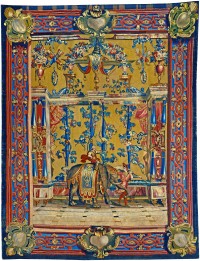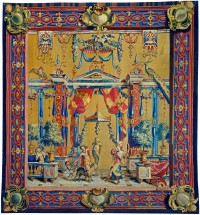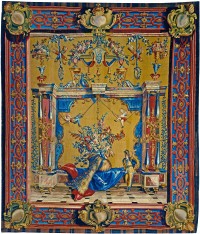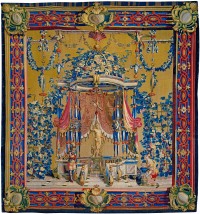 The National Museum of Sweden, has acquired four tapestries that graced an elegant home in late 17th century Stockholm but have been out of the country for more than a century. A large bequest from Gunnar and Ulla Trygg gave the museum, which has no acquisitions budget, the rare opportunity to bring these wall hangings home. They are in exceptional condition.
The National Museum of Sweden, has acquired four tapestries that graced an elegant home in late 17th century Stockholm but have been out of the country for more than a century. A large bequest from Gunnar and Ulla Trygg gave the museum, which has no acquisitions budget, the rare opportunity to bring these wall hangings home. They are in exceptional condition.
The tapestries were made in the early 1690s. They were commissioned by Swedish architect Nicodemus Tessin the Younger to adorn the Stockholm home of Swedish statesman Carl Piper, a commoner whose abilities earned him advancement and a noble title at the court of King Charles XI. In 1690, he married Christina Törne, the daughter of a rich merchant who also happened to be Piper’s stepbrother. His father-in-law/stepbrother gifted the couple a handsome property in Stockholm’s old town. Tessin, then the premier architect in the country who could count the king and queen among his clientele, was given the task of refurbishing the old house.
 Later known as the Grotesques de Berain, the tapestries were mistakenly thought to be the design of Jean Bérain the Elder, a Dutch artist in Paris known for his arabesques and grotesques who was a good friend of Nicodemus Tessin’s, but extensive surviving correspondence between Tessin and Daniel Cronström, the Swedish envoy to Paris, proves that the artist was in fact someone else. Cronström’s was Tessin’s go-to guy in France, a close friend who could negotiate directly with the purveyors of the most fashionable goods and services in Paris. The real designer for the Piper tapestry series was Jean-Baptiste Monnoyer, a Flemish painter who worked for both of the great tapestry workshops in France: Gobelins and Beauvais. He specialized in floral still-lives and was in demand both for his tapestry cartoons and for decorative painting. He worked under Charles Le Brun, then director of the Gobelins factory, on the fresco decorations for royal residence the Château de Marly and under Jean Bérain at the Dauphin’s residence the Château de Meudon.
Later known as the Grotesques de Berain, the tapestries were mistakenly thought to be the design of Jean Bérain the Elder, a Dutch artist in Paris known for his arabesques and grotesques who was a good friend of Nicodemus Tessin’s, but extensive surviving correspondence between Tessin and Daniel Cronström, the Swedish envoy to Paris, proves that the artist was in fact someone else. Cronström’s was Tessin’s go-to guy in France, a close friend who could negotiate directly with the purveyors of the most fashionable goods and services in Paris. The real designer for the Piper tapestry series was Jean-Baptiste Monnoyer, a Flemish painter who worked for both of the great tapestry workshops in France: Gobelins and Beauvais. He specialized in floral still-lives and was in demand both for his tapestry cartoons and for decorative painting. He worked under Charles Le Brun, then director of the Gobelins factory, on the fresco decorations for royal residence the Château de Marly and under Jean Bérain at the Dauphin’s residence the Château de Meudon.
 Tessin commissioned two suites of tapestries from Beauvais: one with a “port de mer” (harbour scenes) theme, the other “grotesques,” meaning a style drawn from the frescoes of ancient Rome which were usually discovered in underground cave-like spaces or “grotte,” in Italian. Curling foliage elements embrace mythological figures (Bacchus, Pan), animals (elephants, peacocks) and heroic figures against the background of Classical architectural elements. Beauvais’ grotesque motif was hugely popular from the time of its launch in 1688 for another 40 years. Carl Piper’s set did not have his coat of arms or monogram in the border because Tessin was in a hurry and the customization would take too much time to complete. Cronström had the idea of making matching chairs with Piper’s monogram. It is a lot easier and faster to weave a monogram onto an upholstered chair than a big ol’ wall hanging. Some of those chairs have survived. Here’s one in the Metropolitan Museum of Art.
Tessin commissioned two suites of tapestries from Beauvais: one with a “port de mer” (harbour scenes) theme, the other “grotesques,” meaning a style drawn from the frescoes of ancient Rome which were usually discovered in underground cave-like spaces or “grotte,” in Italian. Curling foliage elements embrace mythological figures (Bacchus, Pan), animals (elephants, peacocks) and heroic figures against the background of Classical architectural elements. Beauvais’ grotesque motif was hugely popular from the time of its launch in 1688 for another 40 years. Carl Piper’s set did not have his coat of arms or monogram in the border because Tessin was in a hurry and the customization would take too much time to complete. Cronström had the idea of making matching chairs with Piper’s monogram. It is a lot easier and faster to weave a monogram onto an upholstered chair than a big ol’ wall hanging. Some of those chairs have survived. Here’s one in the Metropolitan Museum of Art.
 The tapestries were installed in the Piper palace in early 1696. After that, it’s not clear what happened to them. Carl Piper was taken prisoner in 1709 after the Battle of Poltava in the Great Northern War. He was largely blamed for Sweden’s terrible defeat, accused of having taken bribes from England to sway King Charles XI to the calamitous invasion of Russia which had concluded in such ignominy. Piper and his wife (who did indeed get a lovely pair of diamond earrings as a “gift” from the Duke of Marlborough) were disgraced. Carl died in captivity in Russia in 1716. His formidable wife, who had wielded great power when her husband was an important royal minister, went on to become a real estate mogul, industrialist and philanthropist of immense success.
The tapestries were installed in the Piper palace in early 1696. After that, it’s not clear what happened to them. Carl Piper was taken prisoner in 1709 after the Battle of Poltava in the Great Northern War. He was largely blamed for Sweden’s terrible defeat, accused of having taken bribes from England to sway King Charles XI to the calamitous invasion of Russia which had concluded in such ignominy. Piper and his wife (who did indeed get a lovely pair of diamond earrings as a “gift” from the Duke of Marlborough) were disgraced. Carl died in captivity in Russia in 1716. His formidable wife, who had wielded great power when her husband was an important royal minister, went on to become a real estate mogul, industrialist and philanthropist of immense success.
At some point before 1909, the tapestries left Sweden, probably in the late 19th century. In 1909 they were sold to Louise Mackay, an American collector, who bequeathed them to her son Clarence. After his death in 1938, they were sold at Christie’s in New York and the grotesque tapestry suite was split up. Two other tapestries from the series are now in museums in England and Spain.
 The National Museum is proud to have repatriated four of the tapestries from the grotesque suite. Their exquisite condition and brilliant color would make them a catch for any museum (compare them to the matching armchair to see how pristine they are), but they’re even more significant thanks to that surviving correspondence between Tessin and Cronström. The letters make these suites of tapestries the best-documented personal orders for French tapestries from the 17th century. They’re also the first documented order of tapestries with matching chair upholstery.
The National Museum is proud to have repatriated four of the tapestries from the grotesque suite. Their exquisite condition and brilliant color would make them a catch for any museum (compare them to the matching armchair to see how pristine they are), but they’re even more significant thanks to that surviving correspondence between Tessin and Cronström. The letters make these suites of tapestries the best-documented personal orders for French tapestries from the 17th century. They’re also the first documented order of tapestries with matching chair upholstery.
Absolutely cracking these carpets. And especially while their counterparts are to be found on Helsingor (Elsinor Castle) – http://dansant.org/2011/07/reisdagboek-van-een-danshistoricus-deel-5/ It’s in Dutch, but you can switch on Google Translate. The Photo’s are mine. The link between Berain en Behagle is that Behagle was the factory owner, as you can find out here:
http://www.metmuseum.org/toah/works-of-art/1977.437.1/
Holy smokes, Cor, the comparison between the Helsingor tapestry and the National Museum ones is insane. The colors are unrecognizable. Thanks so much for the link to your wonderful blog. Congratulations on your 7th anniversary! :thanks:
What I remembered was that the Dutch had certain influences in Helsingør. As a kid, I visited the castle, day trippin’ from Helsingborg just across the Øresund, but I do not actively remember any tapestry from there.
In 1659, all Dutch parties and Sweden had settled for the elucidations of the treaty of Elbing, which was then accepted by all parties in the Convention of Helsingör, concluded in Helsingør. But, of course, that is a bit too early.
The described friendship with Tessin the Younger, however, ensured that Berain’s (the Elder’s) own nuance in the Louis XIV style was transmitted to court circles in Sweden. I reckon, apart from that, Monnoyer could have supplied to Beauvais, Gobelins and Berain.
The tapestry is in the last section of the museum. Just before the exit, after the bedrooms and such.